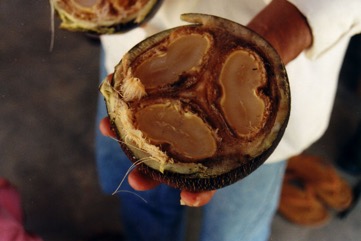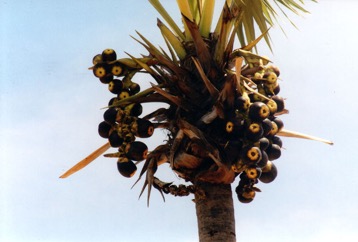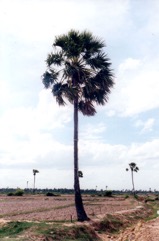Wine palm, Palmyra Palm

A tropical plant. It prefers a well drained soil. It needs a protected sunny position. It is drought and frost tender. Seed need to have a temperature of 24-29°C to grow. Trees need a temperature above 15-18°C. It does better in the drier tropics than in the humid tropics. It grows in seasonally wet and dry areas up to 500 m above sea level. Trees are very sensitive to cold. In Townsville palmetum. It suits hardiness zones 11-12.
Also known as:
Acadiru, Bak taan, Doub palm, Ental, Etal, Giginya, Htan, Kaakala, Karatalamu, Karumpana, Kerigi, Lontar palm, Mak tan kok, Pana, Panai, Panna-maram, Pannei, Pohon siwalan, Kok tan, Nungu, Palem lontar, Palem siwalan, Taad, Taal, Taan, Tad-mar, Tad, Tadi, Tadichettu, Tal, Tala palm, Tale, Talgaha, Tali, Tanta note, Tar, Tatichettu, Than, Thnot, Toddy palm, Yod taan
Synonyms
- Borassus sundaicus Becc.
- Borassus flabelliformis Roxb.
- Borassus tunicata Lour.
- Pholidocarpus tunicatus (Lour.) H. Wendl.
Edible Portion
- Sap, Seeds, Cabbage, Flower spikes, Fruit, Palm heart
Where does Wine palm grow?
Found in: Andamans, Asia, Australia, Bangladesh, Cambodia, China, Côte d'Ivoire, Cuba, East Africa, East Timor, Egypt, Gambia, Himalayas, India, Indochina, Indonesia, Ivory Coast, Laos, Madagascar, Malaysia, Maldives, Mauritania, Myanmar, Nepal, Niger, Nigeria, North Africa, Northeastern India, Pacific, Pakistan, Papua New Guinea, PNG, Philippines, SE Asia, Senegal, South Africa, Southern Africa, Sri Lanka, Sudan, Thailand, Timor-Leste, Vietnam, West Africa, West Timor
Notes: There are 7-10 Borassus species.
Status: The fruit are sold in markets. It is not known if it is used for food in Papua New Guinea. The young seeds are preserved in heavy sugar syrup and sold in jars or cans. It is very important in some countries.
Growing Wine palm, Palmyra Palm
Cultivation: Plants are grown from seed. Seed take 2-6 months to germinate. Seedlings are difficult to transplant so seed should be sown where they are to grow. To extract the sap, male flower stalks give more sap than female. The unopened flower stalk is tied with a string then banged with a mallet for short times over 3 days before the end being sliced off and the sap collected. A small slither is cut off the end each day to keep the sap flowing.
Edible Uses: The flesh and the water of the fruit are edible. They can be eaten fresh or made into ice-cream. Edible starch can be extracted from the stem. The palm heart is edible. The palm can be tapped for sugary sap. This can be drunk, boiled and concentrated or fermented. The seeds are germinated and the young shoots eaten. The swollen storage leaf is eaten either as flour or boiled and dried. CAUTION: The palm hearts have been shown to be toxic to rats even when cooked.
Production: One flower stalk can yield 2 litres per day of sap. One person can tap 30 trees per day. Each flowering stalk will yield for about 3 months. Tapping normally begins when a palm is 20 years old but then may continue for 30 years. A single palm can yield 100,000 litres of palm wine over a 40 year lifespan. The fruit matures in 120 days.
Nutrition Info
per 100g edible portion| Edible Part | Energy (kcal) | Protein (g) | Iron (mg) | Vitamin A (ug) | Vitamin c (mg) | Zinc (mg) | % Water |
|---|---|---|---|---|---|---|---|
| Fruit | 39 | 0.7 | 1.7 | 208 | 35.1 | 0.3 | 89.4 |
| Sap - thickened | 375 | 0.7 | 1.6 | - | - | 0.3 | 5.5 |
| Seed immature | 71 | 0.9 | - | - | - | - | 82.3 |
| Palm heart | 103 | 2.7 | - | - | - | - | 69.5 |
| Stem starch | - | - | - | - | - | - | |
| Seed - Sprouts | 103 | 2.7 | - | - | - | - | 69.5 |
Wine palm, Palmyra Palm Photos




References
Ambasta, S.P. (Ed.), 2000, The Useful Plants of India. CSIR India. p 77
Anderson, E. F., 1993, Plants and people of the Golden Triangle. Dioscorides Press. p 204
Arinathan, V., et al, 2007, Wild edibles used by Palliyars of the western Ghats, Tamil Nadu. Indian Journal of Traditional Knowledge. 6(1) pp 163-168
Arora, R. K., 2014, Diversity in Underutilized Plant Species - An Asia-Pacific Perspective. Bioversity International. p 101
Ashton, M. S., et al 1997, A Field Guide to the Common Trees and Shrubs of Sri Lanka. WHT Publications Ltd. p 78
Bajpai, O., et al, 2015, Tree species of the Himalayan Terai region of Uttar Pradesh, India: a checklist. Check List 11(4): 1718
Balick, M.J. and Beck, H.T., (Ed.), 1990, Useful palms of the World. A Synoptic Bibliography. Colombia p 79, 121, 189, 246, 315, 464, 511, 515, 562, 614,
Balick, M.J. and Beck, H.T., (Ed.), 1990, Useful palms of the World. A Synoptic Bibliography. Colombia p 215, 216, (As Borassus sundaicus)
Bandyopadhyay, S. et al, 2009, Wild edible plants of Koch Bihar district, West Bengal. Natural Products Radiance 8(1) 64-72
Bandyopadhyay, S., et al, 2012, A Census of Wild Edible Plants from Howrah District, West Bengal, India. Proceedings of UGC sponsored National Seminar 2012
Bayton, R. P., 2007, A Revision of Borassus L. (Arecaceae) Kew Bulletin, Vol. 62, No. 4, pp. 561-585
Bircher, A. G. & Bircher, W. H., 2000, Encyclopedia of Fruit Trees and Edible Flowering Plants in Egypt and the Subtropics. AUC Press. p 61
Bodkin, F., 1991, Encyclopedia Botanica. Cornstalk publishing, p 154
Bole, P.V., & Yaghani, Y., 1985, Field Guide to the Common Trees of India. OUP p 85
Brickell, C. (Ed.), 1999, The Royal Horticultural Society A-Z Encyclopedia of Garden Plants. Convent Garden Books. p 183
Brouk, B., 1975, Plants Consumed by Man. Academic Press, London. p 203, 365
Burkill, I.H., 1966, A Dictionary of the Economic Products of the Malay Peninsula. Ministry of Agriculture and Cooperatives, Kuala Lumpur, Malaysia. Vol 1 (A-H) p 350
Chakraborty, S. & Chaturbedi, H. P., 2014, Some Wild Edible Fruits of Tripura- A Survey. Indian Journal of Applied research. (4) 9
Chin, H.F., & Yong, H.S., 1996, Malaysian Fruits in Colour. Tropical press, Kuala Lumpur p 41
Chowdery, T., et al, 2014, Wild edible plants of Uttar Dinajpur District, West Bengal. Life Science Leaflets. 47:pp 20-36 http://lifesciencesleaflets.ning.com
Chowdhury, M. & Mukherjee, R., 2012, Wild Edible Plants Consumed by Local Communities of Maldah of West Bengal, India. Indian J.Sci.Res.3(2) : 163-170
Coronel, R.E., 1982, Fruit Collections in the Philippines. IBPGR Newsletter p 9
Cowie, I, 2006, A Survey of Flora and vegetation of the proposed Jaco-Tutuala-Lore National Park. Timor-Lests (East Timor) www.territorystories.nt/gov.au p 43
Cruz-Garcia, G. S., & Price, L. L., 2011, Ethnobotanical investigation of 'wild' food plants used by rice farmers in Kalasin, Northeast Thailand. Journal of Ethnobiology and Ethnomedicine 7:33
Cundall, P., (ed.), 2004, Gardening Australia: flora: the gardener's bible. ABC Books. p 243
Cundall, P., (ed.), 2004, Gardening Australia: flora: the gardener's bible. ABC Books. p 243 (As Borassus sundaicus)
Das, S. and De, B., 2013, Evaluation of Angiotension I-Converting Enzyme (ACE) inhibitory potential of some underutilized indigenous fruits of West Bengal using an in vitro model. Fruits, Vol. 68:499-506
Dobriyal, M. J. R. & Dobriyal, R., 2014, Non Wood Forest Produce an Option for Ethnic Food and Nutritional Security in India. Int. J. of Usuf. Mngt. 15(1):17-37
Dransfield, J., 1976, Palm sugar in East Madura. Principes 20(30):83-90 (As Borassus sundaicus)
Etherington, K., & Imwold, D., (Eds), 2001, Botanica's Trees & Shrubs. The illustrated A-Z of over 8500 trees and shrubs. Random House, Australia. p 134
Etherington, K., & Imwold, D., (Eds), 2001, Botanica's Trees & Shrubs. The illustrated A-Z of over 8500 trees and shrubs. Random House, Australia. p 134 (As Borassus sundaicus)
Facciola, S., 1998, Cornucopia 2: a Source Book of Edible Plants. Kampong Publications, p 27
Flora of Pakistan. www.eFloras.org
Friday, J. B., 2005, Forestry and Agroforestry Trees of East Timor. http://www.ctahr.hawaii.edu/forestry/data/Timor/Timor trees.html
GAMMIE, (As Borassus flabelliformis)
Garba, A., Useful Plants in the Chad region of North-East Nigeria.
GUPTA & KANODIA, (As Borassus flabelliformis)
Gibbons, M., 1993, Palms. Compact study Guide and Identifier. Sandstone. p 22
Gibbons, M., 2003, A pocket guide to Palms. Chartwell Books. p 52
Haynes, J., & McLaughlin, J., 2000, Edible palms and Their Uses. University of Florida Fact sheet MCDE-00-50-1 p 4
Hearne, D.A., & Rance, S.J., 1975, Trees for Darwin and Northern Australia. AGPS, Canberra p 33,Pl 9
Hedrick, U.P., 1919, (Ed.), Sturtevant's edible plants of the world. p 111
Ibrahim, H. A., et al, 2012, Ethnobotanical Survey of the Wild Edible Food Plants Consumption among Local Communities in Kano State, North-Western, Nigeria, International Journal of Science and Technology. Vol. 2. No. 10 p 716
Jacquat, C., 1990, Plants from the Markets of Thailand. D.K. Book House p 107
Janick, J. & Paul, R. E. (Eds.), 2008, The Encyclopedia of Fruit & Nuts. CABI p 103
Johnson, D.V., 1998, Tropical palms. Non-wood Forest products 10. FAO Rome. p 42, 46, 126
Jones, D.L., 1994, Palms throughout the World. Smithtonian Institution, Washington. p 54, 144
Jones, D.L., 2000, Palms of Australia 3rd edition. Reed/New Holland. p 124
Khan, D. & Shaukat, S.S., 2006, The Fruits of Pakistan: Diversity, Distribution, Trends of Production and Use. Int. J. Biol. Biotech., 3(3):463-499
Kiple, K.F. & Ornelas, K.C., (eds), 2000, The Cambridge World History of Food. CUP p 1882
Krishen P., 2006, Trees of Delhi, A Field Guide. DK Books. p 318
Kumar, S. A., Manus, D. & Mallika, M., 2018, Impact of non-timber forest products on Forest and in Livelihood Economy of the People of Adjoining Areas of Jalpaiguri Forest Division, West Bengal, India. Int. J. of Life Sciences, 2018; 6 (2):365-385
Kuvar, S. D. & Shinde, R. D., 2019, Wild Edible Plants used by Kokni Tribe of Nasik District, Maharashtra. Journal of Global Biosciences. Volume 8, Number 2, 2019, pp. 5936-5945
Martin, F.W. & Ruberte, R.M., 1979, Edible Leaves of the Tropics. Antillian College Press, Mayaguez, Puerto Rico. p 210
Martin, F.W. & Ruberte, R.M., 1979, Edible Leaves of the Tropics. Antillian College Press, Mayaguez, Puerto Rico. p 210 (As Borassus sundaicus and Borassus tunicata)
Martin, F. W., et al, 1987, Perennial Edible Fruits of the Tropics. USDA Handbook 642 p 46
Menninger, E.A., 1977, Edible Nuts of the World. Horticultural Books. Florida p 129
Miguel, E., et al, 1989, A checklist of the cultivated plants of Cuba. Kulturpflanze 37. 1989, 211-357
Morton, J.F., 1988, Notes on Distribution, Propagation, and products of Borassus Palms. Economic Botany 42(3):420-441
Phon, P., 2000, Plants used in Cambodia. © Pauline Dy Phon, Phnom Penh, Cambodia. p 99
Prixar, S., et al, 2006, Species composition, distribution and management of trees in paddy fields in central Laos. p 22
PROSEA (Plant Resources of South East Asia) handbook, Volume 9, 1996, Non seed carbohydrates.
Purseglove, J.W., 1972, Tropical Crops. Monocotyledons. Longmans p 421
Rajapaksha, U., 1998, Traditional Food Plants in Sri Lanka. HARTI, Sri Lanka. p 357
Rashid, H. E., 1977, Geography of Bangladesh. Westview. p 297 (As Borassus flabelliformis)
Reddy, B. M., 2012, Wild edible plants of Chandrapur district, Maharashtra, India. Indian Journal of Natural Products and Resources. 3(1) pp 110-117
Riffle, R.L. & Craft, P., 2003, An Encyclopedia of Cultivated Palms. Timber Press. p 276
Sahni, K.C., 2000, The Book of Indian Trees. Bombay Natural History Society. Oxford. p 182
Sarvalingam, A., et al, 2014, Wild edible plant resources used by the Irulas of the Maruthamalai Hills, Southern Western Ghats, Coimbatore, Tamil Nadu. Indian Journal of Natural Products and Resources 5(2):198-201
Setiya, A. V., et al, 2016, Exploration and documentation of some wild edible plants used by the aboriginals from Gadchiroli District (M.S.) India. International Advanced Research Journal in Science, Engineering and Technology. 3(7)
SHORTT, (As Borassus flabelliformis)
Smith, P.M., 1979, Sugar palm, in Simmonds, N.W., (ed), Crop Plant Evolution. Longmans. London. p 318
Solomon, C., 2001, Encyclopedia of Asian Food. New Holland. p 365
Sp. pl. 2:1187. 1753
Sujarwo, W., et al, 2016, Traditional knowledge of wild and semi-wild edible plants used in Bali (Indonesia) to maintain biological and cultural diversity. Plant Biosystems, 2016, Vol. 150, No. 5, 971-976
Sukarya, D. G., (Ed.) 2013, 3,500 Plant Species of the Botanic Gardens of Indonesia. LIPI p 760
Swaminathan, M.S., and Kochnar, S.L., 2007, An Atlas of major Flowering Trees in India. Macmillan. p 275
Tate, D., 1999, Tropical Fruit. Archipelago Press. Singapore. p 36
Terra, G.J.A., 1973, Tropical Vegetables. Communication 54e Royal Tropical Institute, Amsterdam, p 29
USDA, ARS, National Genetic Resources Program. Germplasm Resources Information Network - (GRIN). [Online Database] National Germplasm Resources Laboratory, Beltsville, Maryland. Available: www.ars-grin.gov/cgi-bin/npgs/html/econ.pl (10 April 2000)
van Wyk, B., 2005, Food Plants of the World. An illustrated guide. Timber press. p 94
WATT, (As Borassus flabelliformis)
Wickens, G.E., 1995, Edible Nuts. FAO Non-wood forest products. FAO, Rome. p164
World Checklist of Useful Plant Species 2020. Royal Botanic Gardens, Kew
www.worldagroforestrycentre.org/sea/products/afdbases/af